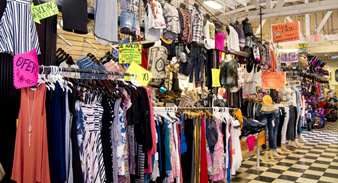Given that 1979, El Faro Plaza has actually become Los Angeles's premiere indoor market, featuring over 250 suppliers, crafters, artists from all over the world, a real mix of Angelenos. This indoor swap meet, located in Los Angeles, is a one-stop shopping mall providing a wide variety of shops, food vendors, and entertainment for the whole family. And all at a fantastic price! From foot massages to vehicle window tinting, from underwear to quinceanera gowns, from unique birds to tvs, we have all of it under one giant roof.An indoor swap meet in the United States, especially Southern California and Nevada, is a kind of bazaar, a permanent, indoor shopping center open during normal retail hours, with fixed booths or storefronts for the vendors.Indoor swap meets home suppliers that sell a wide array of goods and services, specifically clothing and electronic devices. For instance, vendors in the Fantastic Indoor Flea Market in Las Vegas sell
clothes, furniture, bags and toys, ... but there's a heap more: flowers and plants, animal products, leather products, sporting equipment, perfume and cosmetics, luggage and electronics, to name just a few. There also are booths for services, including window tinting, palm reading, alterations, engraving and estate planning. The majority of items sold here are new, although antique street does include some vintage and pre-owned items. It is various in format to an outside swap meet, the equivalent of a flea market, normally open here on a restricted number of days and frequently without fixed locations for its vendors.

Indoor swap meets are present in lots of working-class neighborhoods throughout Southern California, with a concentration in Central Los Angeles. Indoor swap meets include the Anaheim Market, Fantastic Indoor Swap Meet in Las Vegas, and the High Desert Indoor Flea Market in Victorville. [5] Longstanding indoor swap meets that are now defunct include the Pico Rivera Indoor Flea Market [6] and San Ysidro Indoor Swap Meet.Swap meets in the U.S. long included U.S.-born vendors who offered mainly secondhand goods in outside areas. In the 1970s, Latino immigrants started selling cultural products and budget-friendly services at swap meets in Southern California and some swap meets started resembling the tianguis, open-air markets, of Mexico. At the same time, drive-in movie theaters were ending up being less popular, and their owners excitedly rented them out during the day to outside swap meets, which multiplied. Then, mainly Korean immigrants used their connections in the growing import/export trade with Asia to set up their own swap meet stalls and equip them with brand-new, inexpensive goods from Asia instead of previously owned products. In the 1980s and 1990s as residential or commercial properties South Los Angeles and parts of Central L.A. became abandoned and hence, low-cost, Korean immigrants bought them and turned them into indoor swap meets.